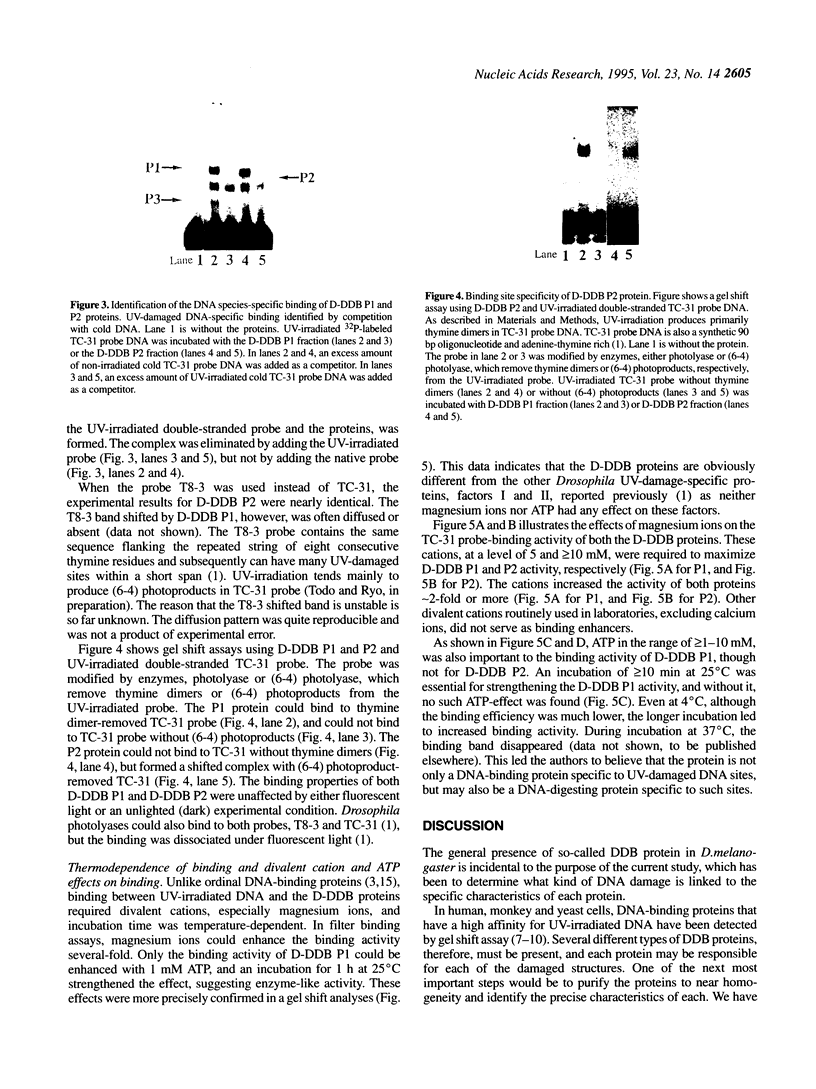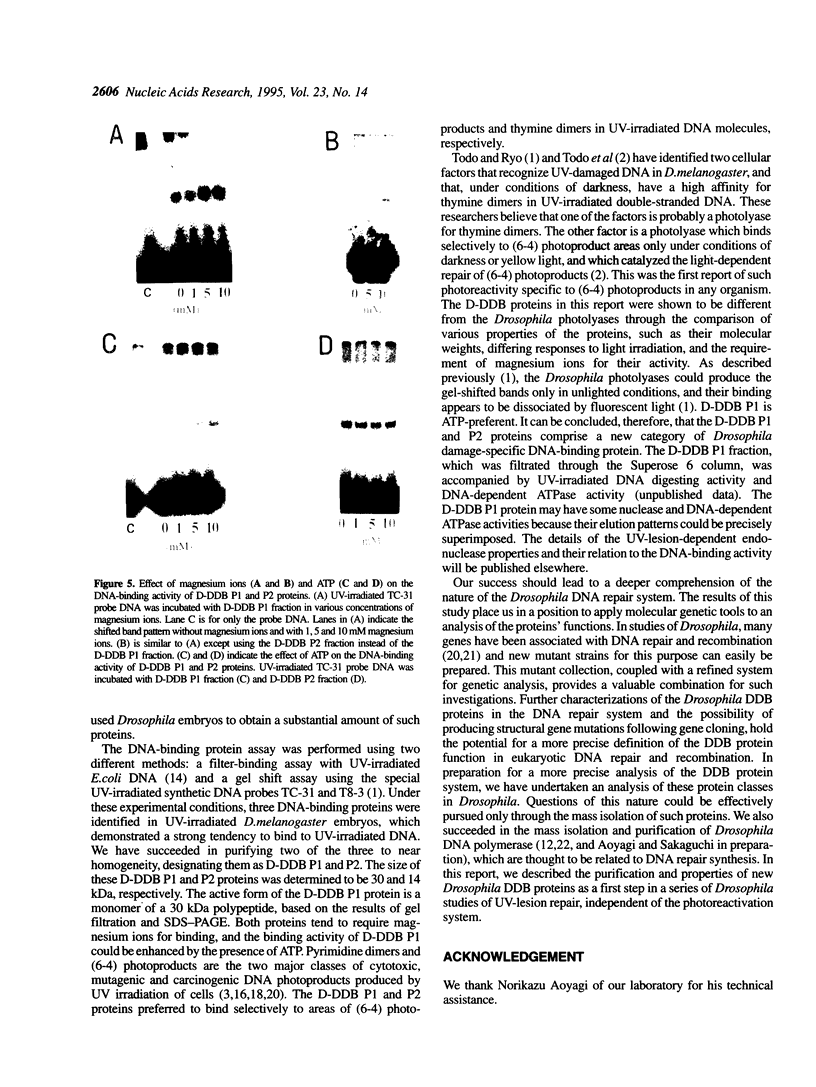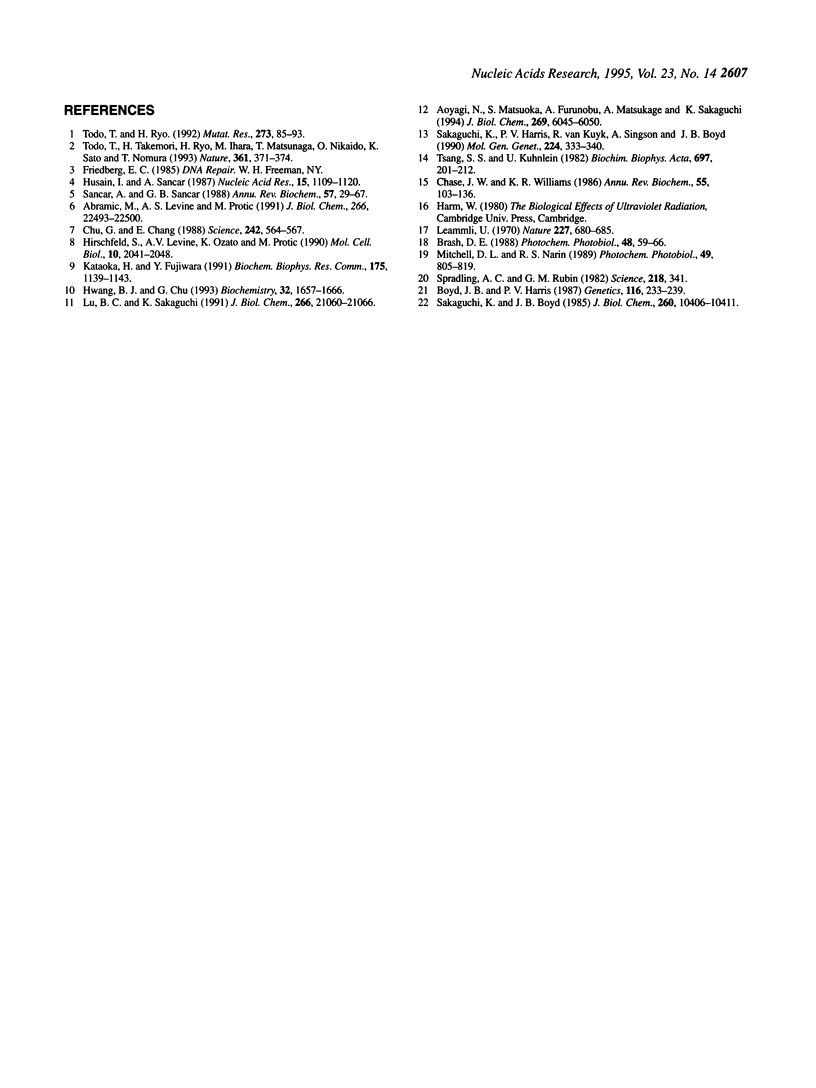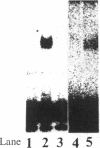Abstract
Three new proteins which selectively bind to UV-damaged DNA were identified and purified to near homogeneity from UV-irradiated Drosophila melanogaster embryos through several column chromatographies. These proteins, tentatively designated as D-DDB P1, P2 and P3, can be identified as different complex bands in a gel shift assay by using UV-irradiated TC-31 probe DNA. Analysis of the purified D-DDB P1 fraction by native or SDS-polyacrylamide gel electrophoresis and FPLC-Superose 6 gel filtration demonstrated that it is a monomer protein which is a 30 kDa polypeptide. The D-DDB P2 protein is a monopolypeptide with a molecular mass of 14 kDa. Both D-DDB P1 and P2 highly prefer binding to UV-irradiated DNA, and have almost no affinity for non-irradiated DNA. Gel shift assays with either UV-irradiated DNA probes demonstrated that D-DDB P1 may show a preference for binding to (6-4) photoproducts, while D-DDB P2 may prefer binding to pyrimidine dimers. Both these proteins require magnesium ions for binding. D-DDB P1 is an ATP-preferent protein. These findings are discussed in relation to two recently described [Todo and Ryo (1991) Mutat. Res., 273, 85-93; Todo et al. (1993) Nature, 361, 371-374] DNA-binding factors from Drosophila cell extracts. A possible role for these DNA-binding proteins in lesion recognition and DNA-binding proteins in lesion recognition and DNA repair of UV-induced photo-products is discussed.
Full text
PDF







Images in this article
Selected References
These references are in PubMed. This may not be the complete list of references from this article.
- Abramić M., Levine A. S., Protić M. Purification of an ultraviolet-inducible, damage-specific DNA-binding protein from primate cells. J Biol Chem. 1991 Nov 25;266(33):22493–22500. [PubMed] [Google Scholar]
- Aoyagi N., Matsuoka S., Furunobu A., Matsukage A., Sakaguchi K. Drosophila DNA polymerase delta. Purification and characterization. J Biol Chem. 1994 Feb 25;269(8):6045–6050. [PubMed] [Google Scholar]
- Boyd J. B., Harris P. V. Isolation and characterization of a photorepair-deficient mutant in Drosophila melanogaster. Genetics. 1987 Jun;116(2):233–239. doi: 10.1093/genetics/116.2.233. [DOI] [PMC free article] [PubMed] [Google Scholar]
- Brash D. E. UV mutagenic photoproducts in Escherichia coli and human cells: a molecular genetics perspective on human skin cancer. Photochem Photobiol. 1988 Jul;48(1):59–66. doi: 10.1111/j.1751-1097.1988.tb02786.x. [DOI] [PubMed] [Google Scholar]
- Chase J. W., Williams K. R. Single-stranded DNA binding proteins required for DNA replication. Annu Rev Biochem. 1986;55:103–136. doi: 10.1146/annurev.bi.55.070186.000535. [DOI] [PubMed] [Google Scholar]
- Chu G., Chang E. Xeroderma pigmentosum group E cells lack a nuclear factor that binds to damaged DNA. Science. 1988 Oct 28;242(4878):564–567. doi: 10.1126/science.3175673. [DOI] [PubMed] [Google Scholar]
- Hirschfeld S., Levine A. S., Ozato K., Protić M. A constitutive damage-specific DNA-binding protein is synthesized at higher levels in UV-irradiated primate cells. Mol Cell Biol. 1990 May;10(5):2041–2048. doi: 10.1128/mcb.10.5.2041. [DOI] [PMC free article] [PubMed] [Google Scholar]
- Husain I., Sancar A. Binding of E. coli DNA photolyase to a defined substrate containing a single T mean value of T dimer. Nucleic Acids Res. 1987 Feb 11;15(3):1109–1120. doi: 10.1093/nar/15.3.1109. [DOI] [PMC free article] [PubMed] [Google Scholar]
- Hwang B. J., Chu G. Purification and characterization of a human protein that binds to damaged DNA. Biochemistry. 1993 Feb 16;32(6):1657–1666. doi: 10.1021/bi00057a033. [DOI] [PubMed] [Google Scholar]
- Kataoka H., Fujiwara Y. UV damage-specific DNA-binding protein in xeroderma pigmentosum complementation group E. Biochem Biophys Res Commun. 1991 Mar 29;175(3):1139–1143. doi: 10.1016/0006-291x(91)91684-5. [DOI] [PubMed] [Google Scholar]
- Laemmli U. K. Cleavage of structural proteins during the assembly of the head of bacteriophage T4. Nature. 1970 Aug 15;227(5259):680–685. doi: 10.1038/227680a0. [DOI] [PubMed] [Google Scholar]
- Lu B. C., Sakaguchi K. An endo-exonuclease from meiotic tissues of the basidiomycete Coprinus cinereus. Its purification and characterization. J Biol Chem. 1991 Nov 5;266(31):21060–21066. [PubMed] [Google Scholar]
- Mitchell D. L., Nairn R. S. The biology of the (6-4) photoproduct. Photochem Photobiol. 1989 Jun;49(6):805–819. doi: 10.1111/j.1751-1097.1989.tb05578.x. [DOI] [PubMed] [Google Scholar]
- Sakaguchi K., Boyd J. B. Purification and characterization of a DNA polymerase beta from Drosophila*. J Biol Chem. 1985 Sep 5;260(19):10406–10411. [PubMed] [Google Scholar]
- Sakaguchi K., Harris P. V., van Kuyk R., Singson A., Boyd J. B. A mitochondrial nuclease is modified in Drosophila mutants (mus308) that are hypersensitive to DNA crosslinking agents. Mol Gen Genet. 1990 Dec;224(3):333–340. doi: 10.1007/BF00262426. [DOI] [PubMed] [Google Scholar]
- Sancar A., Sancar G. B. DNA repair enzymes. Annu Rev Biochem. 1988;57:29–67. doi: 10.1146/annurev.bi.57.070188.000333. [DOI] [PubMed] [Google Scholar]
- Spradling A. C., Rubin G. M. Transposition of cloned P elements into Drosophila germ line chromosomes. Science. 1982 Oct 22;218(4570):341–347. doi: 10.1126/science.6289435. [DOI] [PubMed] [Google Scholar]
- Todo T., Ryo H. Identification of cellular factors that recognize UV-damaged DNA in Drosophila melanogaster. Mutat Res. 1992 Jan;273(1):85–93. doi: 10.1016/0921-8777(92)90052-5. [DOI] [PubMed] [Google Scholar]
- Todo T., Takemori H., Ryo H., Ihara M., Matsunaga T., Nikaido O., Sato K., Nomura T. A new photoreactivating enzyme that specifically repairs ultraviolet light-induced (6-4)photoproducts. Nature. 1993 Jan 28;361(6410):371–374. doi: 10.1038/361371a0. [DOI] [PubMed] [Google Scholar]
- Tsang S. S., Kuhnlein U. DNA-binding protein from HeLa cells that binds preferentially to supercoiled DNA damaged by ultraviolet light or N-acetoxy-N-acetyl-2-aminofluorene. Biochim Biophys Acta. 1982 May 31;697(2):202–212. doi: 10.1016/0167-4781(82)90078-1. [DOI] [PubMed] [Google Scholar]







